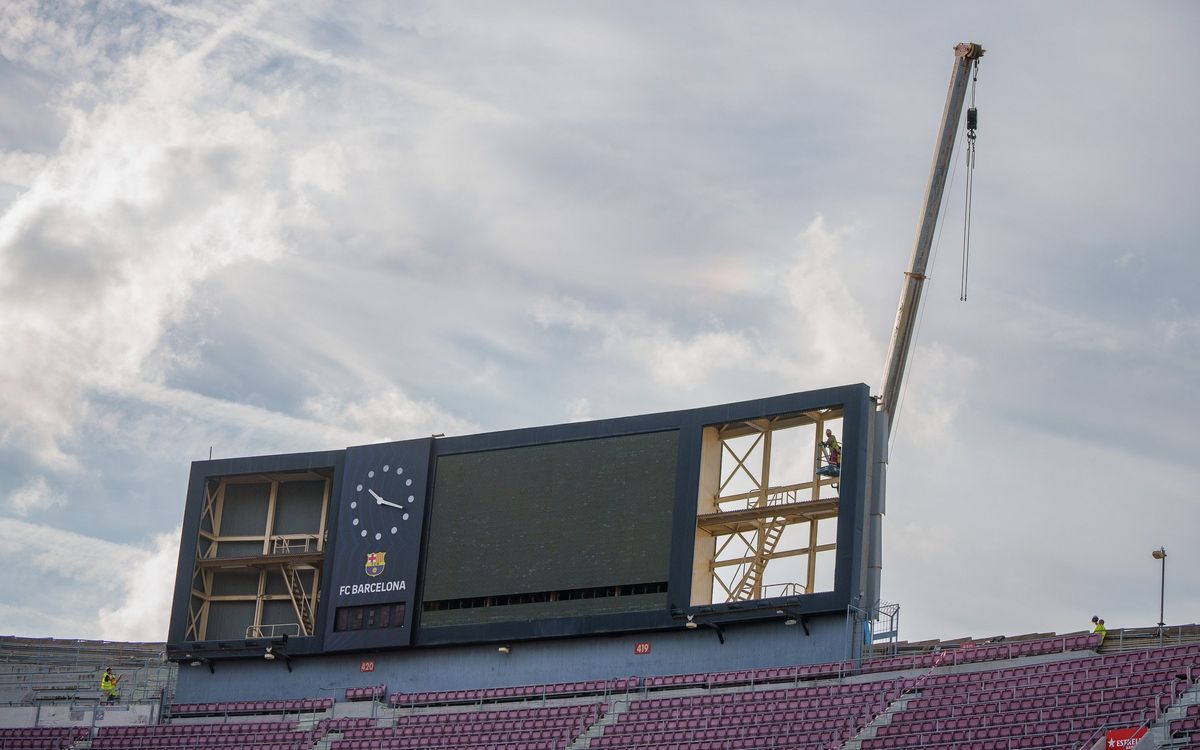Video scoreboard removal marks the start of the partial demolition of the Spotify Camp Nou South Goal third tier
- Viber
- Messenger
- Copy link
FC Barcelona continue work on the Spotify Camp Nou, the epicentre of Espai Barça, with mainly the third tier of the South Goal zone affected. Preparation work on the zone started on September 1 with the removal of equipment and fittings, and the South Goal video scoreboard will be removed from Friday September 9, meaning it will not be working during this season's first Champions League game against Viktoria Pilsen. This marks the start of the partial demolition of the third tier, making use of the break from LaLiga to play the World Cup in November and December.
The work will consist of removing the outer ring, the South Goal façade cantilever roof (housing the Asistencia Sanitaria medical centre), and half of the South Goal third tier, which acts as a counterweight. There are three scheduled demolition phases. The first involves the preliminary work up to the break for the World Cup. The second will see the partial demolition of the third tier, mainly involving the removal of the main structure, with new stairs and escape routes prepared to reuse the second tier seats that remain unaffected by the work, while ensuring the highest safety levels for all fans.
Seats and affected areas removed from October
Once the South Goal video scoreboard has been removed, the seats and fittings will be removed, along with the railings and beams. The work in October will mainly affect the third tier, which will see the loss of 3,782 seats, 3,182 of which belong to season ticket holder seats, who have been informed and will be relocated to similar areas, or will take a temporary moratorium on their season ticket payment. When it comes to the second tier, the affected 1,215 season ticket holders, located between accesses 315 and 322, will no longer have a roof over their seats, for which the Club has adjusted the price correspondingly. Of the more than 4,300 affected season ticket holders, 2,675 have been relocated, and 575 have requested leave of absence.
As such, the work will be concentrated between gates 34 and 46, affecting some of the second and third tier accesses. When it comes to the second tier, it will be accesses 315 even numbered seats to 322 odd numbered seats - only between and including rows 34 to 37. When it comes to the third tier, the work will affect accesses 521 – 522 and 415, even numbered seats, to 422, odd numbered seats. Also, it will affect six VIP boxes in the second tier and the area where away fans are normally located. Due to this preliminary work, rival fans for the Viktoria Pilsen game have been moved to one access (from 521 to 522 even numbers up to access 525 odd numbers).
Benefits of bringing the work forward
Despite the plans put into practice by the Club scheduling most of the stadium construction work to be done after the 2022/23 season, the option to bring forward part of the work to the break from LaLiga to play the World Cup, and start the partial demolition of the South Goal third tier presented an opportunity. The construction process benefits in two ways. Firstly to get on with a considerable number of tasks involved with the work, which will enable good progress on the majority of the work scheduled for next summer. Furthermore, it is also a pilot project and ratifies the implementation of procedures and technologies specifically designed for the remodelling of the Spotify Camp Nou.
Let's not forget that the remodelling of the future stadium requires the design of construction processes based on industrialisation, which as opposed to traditional construction, involves managing the production phase and prototype testing beforehand. As such, both the demolition operations and the construction procedures for the structure's main elements could be tested in order to determine the most efficient solutions, enabling precise and reliable replication during the remainder of the construction.
- Viber
- Messenger
- Copy link

